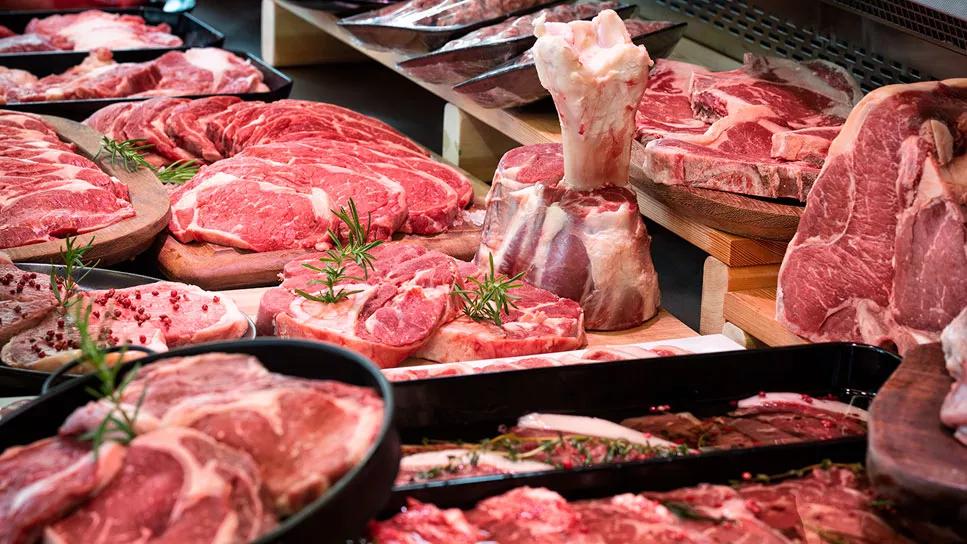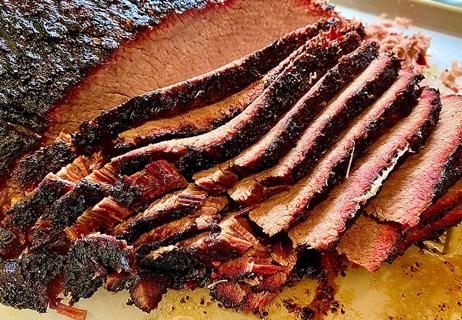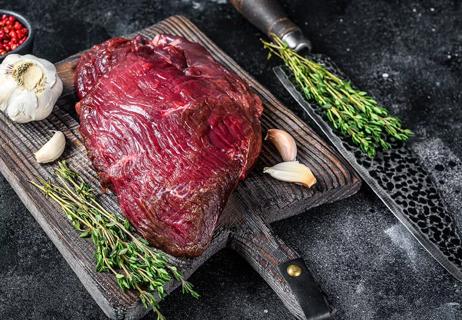It has nutrients your body needs, but it also comes with some serious health risks

It’s the age-old food debate: Is red meat healthy or not?
Advertisement
Cleveland Clinic is a non-profit academic medical center. Advertising on our site helps support our mission. We do not endorse non-Cleveland Clinic products or services. Policy
But the answer isn’t straightforward. Put simply: It depends. Generally speaking, choosing white meat or vegetarian options is your best bet for living an overall healthier lifestyle. But the health benefits and consequences of red meat often boil down to what you’re eating, how often and how much.
“Growing research has shown negative health impacts with frequent consumption of red meat, especially processed red meat,” warns registered dietitian Julia Zumpano, RD, LD.
She discusses the pros, cons and everything you should consider when it comes to consuming red meat.
“Meats are categorized as either white or red based on the amount of myoglobin found in an animal’s muscles,” Zumpano explains. “Myoglobin is a protein found in meat that produces a red color when it’s exposed to oxygen.”
Red meat, then, is the muscle meat of mammals. This category includes:
A related category is processed meats: Meat that’s been preserved by smoking, curing, salting or adding chemical preservatives, like:
There are many healthy vitamins, minerals and other nutrients in red meat, and it can be a good source of protein, B vitamins, iron and zinc. But it also comes with some health risks, like raising your risk of certain types of cancer, increasing your risk of cardiovascular disease and contributing to havingobesity.
Advertisement
“There is evidence that shows that too much red meat is not good for your health,” Zumpano says. “But the quality, quantity and frequency of the red meat you eat all play a big role on the health risks.”
Red meats are high in saturated fats, which can cause elevated levels of LDL (“bad” cholesterol) and put you at risk for cardiovascular disease.
“High cholesterol can lead to more plaque buildup and atherosclerosis, a hardening of the plaque in the arteries, which can lead to increased cardiovascular events like heart attack and stroke,” Zumpano explains.
Here’s something you may not realize: The International Agency for Research on Cancer (IARC) classifies red meat as a Group 2A carcinogen, which is described as “probably carcinogenic to humans.” Carcinogens are substances with cancer-causing potential. Yikes!
A review of studies on the relationship between red meat and cancer found that eating high levels of red meat is associated with a higher risk of:
That’s not all: Processed meats are categorized as level 1 carcinogens. This puts them in the same category as cigarettes and asbestos and means they’re known to increase your risk of cancer.
Studies show that eating red and processed meat is associated with higher rates of having obesity in both children and adults.
Your health is critical — but there are other good reasons to consider scaling back on (or cutting out) red meat, too.
“Meat costs significantly more than vegetarian proteins like beans, nuts and tofu,” Zumpano says. “Replacing just one omnivore meal with a vegetarian meal each week can build up to significant savings.”
Your wallet isn’t the only one that will benefit from your scaled-back meat consumption. The environment will thank you, too.
“Raising cattle significantly impacts the environment, and cattle themselves produce significant amounts of greenhouse gases,” Zumpano continues. “Cutting back on your meat consumption helps keep our planet healthy for future generations.”
“Anytime you eat red meat, it should be the leanest cut you can find, with all the fat removed,” Zumpano advises. Here are some examples of lean cuts:
Advertisement
The way you cook meat matters, too. When you prepare red meat, skip the pan-frying and deep frying, and instead focus on dry cooking methods, like:
“Avoid all processed meats, fatty cuts of meat and fried meats,” Zumpano reiterates.
When it comes to red meat, stick to quality (lean cuts) and pay attention to quantity.
For the sake of quality, Zumpano says to consider choosing grass-fed and organic red meat, which have been proven to provide more nutrients and have lower exposure to growth hormones, antibiotics and pesticides when compared to conventional meat.
“In general, we know that the more red meat you consume, the greater your risk of developing heart disease,” she continues. “We don’t provide a set number of servings of red meat per week, as that’s specific to each person and depends on risk factors and other sources of saturated fat they’re consuming. But if you have high cholesterol or are trying to prevent heart disease due to family history or other risk factors, you should consume as little red meat as possible.”
Instead of focusing on avoidance, she says to aim to eat a variety of protein sources, including fish and seafood, poultry, eggs/egg whites, beans, lentils, nuts and seeds. Pair that with a rainbow of fruits and vegetables to set yourself on a path toward disease prevention.
Advertisement
Zumpano reiterates that some people may benefit from more red meat than others, based on their health needs. For specific guidelines, it’s best to chat with a healthcare provider or make an appointment to speak with a dietitian.
People who don’t eat red meat or who greatly limit it generally take in fewer calories, less fat and have a lower risk of heart disease and death.
A healthy eating style minimizes red meat and prioritizes plant-based protein sources like legumes and nuts. A great example is the Mediterranean diet, which also incorporates white meat and fish.
“The hope is that as you incorporate lean meats, seafood and plant-based proteins, you’ll eventually start to decrease the amount of red meat and processed meats you’re eating,” Zumpano says.
Zumpano shares tips for scaling back on your red meat consumption.
Cook fish or seafood one night per week — or more! Zumpano says dietitians recommend eating three meals a week of fish, especially fish that are high in omega-3 fatty acids and low in mercury.
But if you’re just getting into seafood, any type will do. Use either fresh, frozen or canned, and start adding it into your weekly menu rotation. If you’re choosing a canned fish, be sure to choose lower-mercury options and to keep an eye on the sodium content.
Advertisement
“Start with a type of fish you already know you like, whether it's shellfish, whitefish, salmon or even canned tuna,” Zumpano suggests. “Experiment a little bit with cooking styles to start incorporating it into your meals on a weekly basis, like by instituting Tuna Taco Tuesday, Salmon Sunday or Fish Friday. (Notice I left out the ‘fry’ part!)”
Not sure where to start? Try these:
When you’re cooking your favorite recipe and it calls for ground beef or pork, why not reach for ground turkey or chicken instead? These white meat options work great in dishes like tacos and chili, and they don’t bring the same health risks as red meat.
“If you have trouble making the switch, sub out half of the red meat for poultry,” Zumpano recommends.
Of course, you can also go for recipes that are already based around white meat. Try tasty options like:
“Skinless poultry is the leanest choice,” Zumpano says, “and just be sure you stick to those dry cooking methods we talked about before.”
Meat isn’t the only protein source in town. Beans and legumes (like chickpeas and lentils) are a great source of protein, too, and they’re packed with healthy nutrients.
“Add legumes to your diet to provide a good source not just of plant protein but of fiber, vitamins and minerals, as well,” Zumpano recommends. “Use some beans on a salad instead of putting meat on it, or make a bean soup.”
These recipes will get you started:
“Although beans and legumes may not be as high in protein by volume as meat, they have a lot of other benefits that the meat doesn’t have,” Zumpano notes, “with none of the risks.”
Ever heard of Meatless Mondays? More than just fun alliteration, it’s a national movement to go vegetarian on the first day of the week — but if another day works for best for you and your family, just choose that day instead.
“If you’re currently eating red meat most days, start with including one meatless meal per week and then progress to an entire day without meat,” Zumpano suggests. “This is a great way to ease into going meatless and provides a great opportunity to try new foods and recipes.”
Look into meat substitutes like:
“You don't necessarily need to become a vegetarian or avoid an entire food group completely,” she continues. “Just start incorporating one meatless day a week, then continue to progress from there to see what you're comfortable with.”
Meals are always more fun when they’re shared. Make meatless dishes a household affair by serving them up tapas-style.
“People sometimes find planning a vegetarian meal intimidating if they’re accustomed to eating a dinner with a main dish of meat,” Zumpano says. “To ease into it, try making three or four vegetarian side dishes and serve them family-style.”
You can even let each member of the family pick a dish. Turn it into a complete meal by including a grain (like brown rice or quinoa), a vegetable (or two or three!) and a bean-based dish (think edamame, chickpeas or black beans).
Here are a few ideas to get you started:
Imitation meat products are OK sometimes (veggie dogs at a cookout, anybody?), but for the most part, Zumpano says that it’s best to choose whole-food sources of meat alternatives instead.
“Focus on choosing recipes that highlight vegetables, rather than hiding them,” she encourages.
Not yet a big fan of veggies? Go easy on yourself as you practice making them a regular part of your diet. Again, start with the ones you enjoy and expand slowly from there. Tips for getting kids to eat vegetables can go a long way for adults, too!
Learn more about our editorial process.
Advertisement

Simple swaps improve a comfort food staple.

Simple swaps improve a comfort food staple.

Packed with iron, vitamin A and protein, beef liver provides a healthy low-calorie meat option

Organ meat is packed with nutrients, but it’s not good for everyone

They’re classified as carcinogenic because of their link to cancer

Keep these tips in mind during hunting season

Type 2 diabetes isn’t inevitable with these dietary changes

Applying a hot or cold compress can help with pain